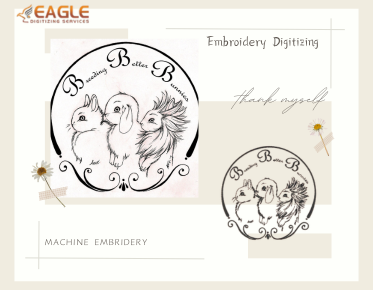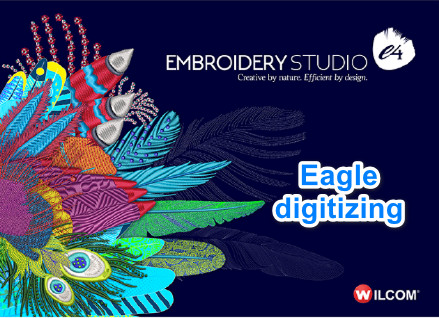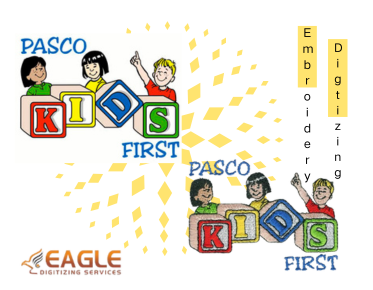The Ultimate Guide to 3D Puff Embroidery Digitizing
Embroidery has always been a cherished craft, but 3D puff embroidery takes it to a whole new level. Imagine designs that literally stand out, adding depth and a touch of luxury to everyday items. This technique isn't just about stitching—it's about creating art that pops.
What
is 3D Puff Embroidery Digitizing?
3D puff embroidery digitizing involves creating raised, textured designs using foam underlayments. This technique turns flat stitches into dynamic, three-dimensional works of art. It's particularly popular for logos and designs on caps, jackets, and other apparel where a standout effect is desired.
How
3D Puff Embroidery Stands Out
3D puff embroidery stands out due to its tactile nature. Unlike traditional flat embroidery, it offers a raised effect that you can see and feel. This dimension adds a premium touch to any garment, making logos and designs more noticeable and visually appealing.
History
and Evolution of 3D Puff Embroidery
The origins of 3D puff embroidery can be traced back to the late 20th century when innovative embroiderers began experimenting with foam to add depth to their designs. Over the years, advancements in materials and digitizing software have refined the process, making it more accessible and popular in the fashion industry.
The
Process of Creating 3D Puff Embroidery
Creating 3D puff embroidery involves several steps. First, the design is digitized with specific settings to accommodate the foam. Then, foam is placed on the fabric, and the embroidery machine stitches over it. The excess foam is removed, leaving a raised design. Each step requires precision to ensure the final product is perfect.
Materials
Overview: Essentials and Options
Fabric Selection for 3D Puff
Embroidery
Choosing the right fabric is crucial for successful 3D puff
embroidery. Consider factors like fabric weight, weave, and stretchability to
ensure optimal results.
Cotton,
Polyester, and Blends: Pros and Cons
Each fabric type has its advantages and considerations. Cotton offers
a natural feel but may shrink, while polyester is durable and retains color
vibrancy. Blends combine the best of both worlds.
Color
Considerations for Fabric
Color plays a significant role in 3D puff embroidery. Consider the background fabric color when choosing thread and foam colors for contrast and visibility.
Thread Options for 3D Puff
Embroidery
Thread
Types: Rayon, Polyester, Metallic, etc.
Various thread types offer different effects. Rayon provides a smooth
finish, polyester offers durability, and metallic threads add shimmer and
sparkle.
Thread
Weight and Thickness
The weight and thickness of the thread affect the overall look of the
embroidery. Experiment with different weights to achieve the desired texture
and coverage.
Color
Matching and Contrast
Achieving color harmony is essential. Match thread colors to the design for a cohesive look, and use contrasting colors strategically to highlight 3D elements.
Backing and Stabilizers
Importance
of Backing in 3D Puff Embroidery
Backing provides stability and support for 3D puff embroidery. Choose
a backing material that complements your fabric and design complexity.
Types
of Backing Materials
Common backing materials include tear-away, cut-away, and water-soluble
stabilizers. Select the appropriate type based on the fabric and design
requirements.
Stabilizers
for Added Support
Embroidery stabilizers prevent fabric distortion during embroidery. Use multiple layers or specialty stabilizers for intricate designs and heavyweight fabrics.
Hooping and Framing
Hooping
Techniques for 3D Puff Embroidery
Proper hooping is critical for maintaining tension and alignment. Use
hooping aids and techniques to achieve even stitches and avoid puckering.
Framing
Options: Traditional vs. Magnetic
Traditional frames and magnetic hoops offer different advantages.
Choose the framing option that best suits your embroidery machine and project
requirements.
Avoiding
Fabric Distortion
Prevent fabric distortion by hooping fabrics with care. Use stabilizers and adjust tension settings to minimize stretching or puckering.
Needles and Bobbins
Needle
Types for 3D Puff Embroidery
Specialized needles designed for heavy threads and fabrics are ideal
for 3D puff embroidery. Choose needle sizes and styles that match your thread
and fabric combination.
Understanding
Needle Sizes and Styles
Needle sizes and styles vary based on fabric thickness and thread
weight. Consult your machine's manual for recommendations and experiment to
find the optimal needle for your projects.
Bobbin
Selection and Winding
Wind bobbins with matching thread colors for seamless embroidery. Adjust bobbin tension to prevent thread bunching or looping on the underside of the design.
3D Puff Foam
Types
of 3D Puff Foam
Choose from different foam types, including high-density and
low-density options. Consider foam thickness and compressibility for desired 3D
effects.
Thickness
and Density Considerations
Foam thickness determines the height of the 3D effect. Experiment with
different foam densities to achieve varying degrees of elevation in your
designs.
Applying
Foam for Dimensional Effects
Place foam inserts strategically under areas of the design that require elevation. Secure foam with temporary adhesive or basting stitches before embroidery.
Heat Tools and Techniques
Heat
Press vs. Steam Iron: Pros and Cons
Heat tools activate foam and enhance 3D effects. Heat presses offer
uniform heat distribution, while steam irons provide targeted heat control.
Applying
Heat for Foam Activation
Activate foam by applying heat evenly across the design. Use a pressing cloth to protect delicate fabrics and prevent heat damage.
Step-by-Step
Guide to 3D Puff Embroidery Digitizing
- Digitize the
Design: Use digitizing software to create a design with settings for the
3D puff.
- Prepare the
Fabric: Hoop the fabric with a suitable backing.
- Place the
Foam: Position the foam on the fabric where the raised effect is desired.
- Start
Embroidering: Stitch over the foam, ensuring the stitches are dense enough
to cover the foam completely.
- Remove
Excess Foam: Carefully tear away the excess foam from around the design.
- Final Touches: Use a heat gun to remove any leftover foam pieces.
Advantages
of 3D Puff Embroidery Over Flat Embroidery
3D puff embroidery offers several advantages over flat embroidery. It
provides a unique texture and depth that makes designs more eye-catching. This
raised effect adds a professional and high-end look, enhancing the overall
appeal of the garment.
Adding Depth and Dimension to
Your Designs
Incorporating 3D elements into your embroidery designs adds an
intriguing layer of depth and dimension. This technique is perfect for making
logos, monograms, and intricate patterns stand out, turning ordinary items into
extraordinary pieces.
Enhancing Visual Appeal with 3D
Puff Embroidery
3D puff embroidery enhances visual appeal by creating a striking
contrast between the flat fabric and the raised design. This contrast draws
attention and adds a sophisticated touch, making the garment more attractive
and stylish.
Durability and Longevity of 3D
Puff Embroidered Items
Items embroidered with 3D puff are durable and long-lasting. The foam used
in the process is resilient and holds its shape well over time. When properly
cared for, 3D puff embroidery can withstand regular wear and washing without
losing its dimensional effect.
Versatility of 3D Puff
Embroidery in Fashion
3D puff embroidery is incredibly versatile in fashion. It can be used on a wide range of items, from casual wear like caps and t-shirts to more formal attire like blazers and dresses. This versatility makes it a favorite among designers looking to add a unique flair to their collections.
Popular
Uses for 3D Puff Embroidery in Apparel
In apparel, 3D puff embroidery is commonly used for logos on caps,
varsity jackets, and sports uniforms. It's also popular for personalizing items
such as hoodies and tote bags, adding a touch of individuality and style.
3D Puff Embroidery for Hats and
Caps
Hats and caps are perhaps the most popular items for 3D puff embroidery. The technique adds a bold, eye-catching element to headwear, making logos and designs pop. This is why many sports teams and fashion brands opt for 3D puff embroidery on their caps.
Making
Your Brand Stand Out with 3D Puff Embroidery
Incorporating 3D puff embroidery into your branding can make your
products stand out. The raised designs attract attention and convey a sense of
quality and detail that flat embroidery cannot match. It's an excellent way to
make your brand memorable and distinguishable.
3D Puff Embroidery in
Promotional Products
3D puff embroidery is also effective for promotional products. Items like branded caps, bags, and jackets with raised logos make a lasting impression on clients and customers. These items not only promote your brand but also reflect a high level of craftsmanship and attention to detail.
Challenges
and Solutions in 3D Puff Embroidery Digitizing
Digitizing for 3D puff embroidery comes with its challenges, such as
achieving the right stitch density and ensuring proper foam coverage. Solutions
include using specialized digitizing software, experimenting with different
foam thicknesses, and conducting test runs to perfect the settings.
Troubleshooting Common Issues in
3D Puff Embroidery
Common issues include foam peeking through the stitches or the design
not raising as expected. Troubleshooting these problems involves adjusting the
stitch density, using the correct foam thickness, and ensuring the machine
settings are optimized for 3D embroidery.
Tips for Perfecting Your 3D Puff
Embroidery Techniques
To perfect your 3D puff embroidery, practice is key. Experiment with different designs, foam thicknesses, and stitch densities. Pay attention to the details and don't rush the process. Additionally, always use high-quality materials to achieve the best results.
Incorporating
3D Puff Embroidery into Your Business
Adding 3D puff embroidery to your business can open up new opportunities. It allows you to offer unique products that stand out in the market. Promote this service to attract customers looking for distinctive and high-quality embroidery options.
Future
Trends in 3D Puff Embroidery
The future of 3D puff embroidery looks promising, with trends leaning towards more intricate and innovative designs. Advances in digitizing software and embroidery machines will continue to enhance the possibilities, making it easier to create complex and stunning 3D effects.
3D puff embroidery digitizing is growing in popularity for a good reason. And eagle digitizing
provide 3D embroidery digitizing services. Its ability to
add depth, texture, and a premium feel to garments makes it a valuable
technique for both hobbyists and professionals. As the fashion and promotional
product industries continue to evolve, 3D puff embroidery will undoubtedly
remain a sought-after method for creating standout designs.



